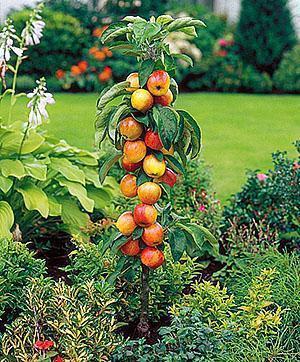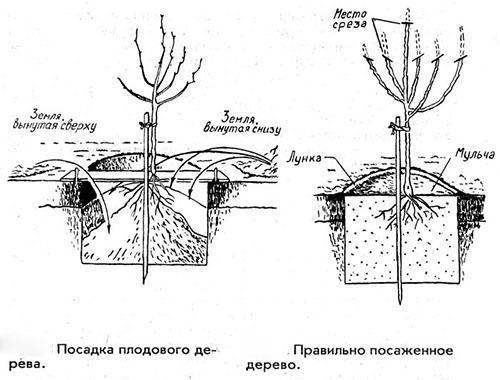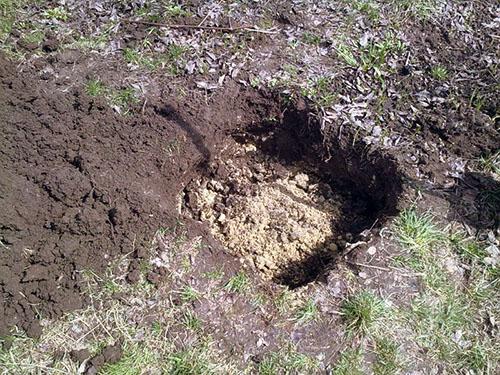Planting and caring for a columnar apple tree
 A natural mutation of the apple tree, which has awakened the interest of breeders in obtaining high-yielding varieties of columnar apple trees, was noticed a little over 50 years ago in Canada. All the young trees obtained by grafting became an exact copy of an unusual branch, apples were located on short fruit branches and even on an erect stem.
A natural mutation of the apple tree, which has awakened the interest of breeders in obtaining high-yielding varieties of columnar apple trees, was noticed a little over 50 years ago in Canada. All the young trees obtained by grafting became an exact copy of an unusual branch, apples were located on short fruit branches and even on an erect stem.
Already in the 80s, the first varieties of compact, yielding apple trees were created, which instantly interested domestic gardeners. True, due to the unusual structure of columnar apple trees, planting and caring for plants has its own characteristics.
The main difference between the columnar and the usual fruit trees is that the plants grow much more slowly as a result of mutation, which is especially true for the lateral shoots and the root system.
The benefits of such a feature become obvious:
- when planting on a small plot of land, you can create a full-fledged apple orchard;
- when caring for columnar apple trees, since it is easier to harvest from low compact crowns, it is easier to prune and treat trees from pests.
And the number of flower buds formed on the tiny lateral branches is amazing.
How to plant an apple tree correctly?

 The requirements for arranging a planting pit for columnar apple trees and planting dates are the same as for ordinary fruit trees. Therefore, wondering how to plant an apple tree correctly, you can safely focus on recommendations regarding traditional low-growing varieties. It is important to:
The requirements for arranging a planting pit for columnar apple trees and planting dates are the same as for ordinary fruit trees. Therefore, wondering how to plant an apple tree correctly, you can safely focus on recommendations regarding traditional low-growing varieties. It is important to:
- the root system was not crowded or damaged, and the root collar was located slightly above the ground;
- the pit itself was prepared at least two weeks before the plant was planted in the ground, since it is during this time that the soil will have time to settle and the root collar will gradually not be under the soil.
 If a columnar seedling is obtained by grafting, deepening the joint between the rootstock and the scion threatens to lose its grade.
If a columnar seedling is obtained by grafting, deepening the joint between the rootstock and the scion threatens to lose its grade.
Into the dug hole they bring:
- 50-100 grams of superphosphate;
- 50–80 grams of potash fertilizers or up to 400 grams of ash;
- 3-5 kg of rotted compost or humus.
Since the root system of columnar apple trees is often very vulnerable, after filling the hole with soil, they compact it very carefully and then mulch abundantly. peat, cut grass or sawdust.
If the planting is carried out correctly, the apple tree is gaining color already at the age of 2-3 years. And the quality and quantity of fruits will depend on the subsequent care of the apple trees in the summer and in other periods of the year.
Pruning scheme for columnar apple trees
 Pruning of columnar apple trees is carried out not only in order to maintain the appearance of the crown and remove old or damaged branches, the regularity of fruiting and the quality of ripening apples largely depend on this procedure.
Pruning of columnar apple trees is carried out not only in order to maintain the appearance of the crown and remove old or damaged branches, the regularity of fruiting and the quality of ripening apples largely depend on this procedure.
 The role of a kind of core of the entire tree is played by a guide shoot, which sets the vertical growth of the entire apple tree. This shoot is not pruned, but tied to a solid support. If the apical bud is damaged, or the main shoot annually grows less than 10-15 cm and two or three lateral branches, it is cut off, leaving 2-3 healthy buds for renewal.Although the growth of lateral branches in columnar apple trees is greatly slowed down, the trees are able to form quite powerful shoots.
The role of a kind of core of the entire tree is played by a guide shoot, which sets the vertical growth of the entire apple tree. This shoot is not pruned, but tied to a solid support. If the apical bud is damaged, or the main shoot annually grows less than 10-15 cm and two or three lateral branches, it is cut off, leaving 2-3 healthy buds for renewal.Although the growth of lateral branches in columnar apple trees is greatly slowed down, the trees are able to form quite powerful shoots.
If you look at the crown of such a tree, you will notice:
- the closer the branch is to the vertical, the stronger its growth;
- horizontal small branches give minimal growth, and the bulk of flower buds are laid on them.
The most powerful upright competing shoots are either cut into a ring, or based on them, with the help of competent pruning, they form fruiting zones. Moreover, the formation of the crown of an apple tree begins in early spring already in the first year of the tree's life.
The scheme for pruning a columnar apple tree is quite simple:
- In the spring, before the juices begin to move, the lateral shoot is cut so that only two active buds remain, which will give strong branches over the summer.
- The next year, a one-year-old shoot, located closer to the horizontal, will lay flower buds, and then ovaries. And the young branch, which is directed upwards, is again cut into two buds.
- In the third spring, the branches that bore fruit last year are removed, and the rest of the procedure is repeated as before.
Fruiting zones, formed on the basis of lateral shoots, yield from 3 to 5 years, after which they are cut into a ring, due to which a stem of a slowly growing tree is formed.
 By demonstrating the intricacies of trimming columnar apple trees, you can study in detail all the stages of this mandatory plant care measure. Sometimes gardeners are faced with a situation where flower buds formed on the trunk itself, after pruning, are reborn into side shoots. In this case, it is better not to wait until lignification begins, and to include the removal of still green rudiments of branches in the regular care of the apple tree in summer and spring.
By demonstrating the intricacies of trimming columnar apple trees, you can study in detail all the stages of this mandatory plant care measure. Sometimes gardeners are faced with a situation where flower buds formed on the trunk itself, after pruning, are reborn into side shoots. In this case, it is better not to wait until lignification begins, and to include the removal of still green rudiments of branches in the regular care of the apple tree in summer and spring.
Caring for columnar apple trees
 Cultivation of columnar apple trees requires constant attention to planting and rather painstaking care from the gardener. Moreover, caring for columnar apple trees is required already at the stage when the plant blooms. The fact is that a compact tree with a small crown is literally covered with flowers, therefore, especially in the first years of life, it is necessary to strictly ration the future harvest:
Cultivation of columnar apple trees requires constant attention to planting and rather painstaking care from the gardener. Moreover, caring for columnar apple trees is required already at the stage when the plant blooms. The fact is that a compact tree with a small crown is literally covered with flowers, therefore, especially in the first years of life, it is necessary to strictly ration the future harvest:
- If the seedling has bloomed already in the first spring, it is better to remove all the buds, since fruiting is a serious test for a plant that has not had time to properly acclimatize.
- In the second year, up to five fruits can ripen on the tree.
- Gradually, the load is increased, making sure that the apples do not grow smaller from year to year, which may be a sign of tree congestion.
Rationing consists in carefully removing excess peduncles.
On each fruiting branch and trunk, twice as many buds are left as apples should ripen. On average, two inflorescences are left on the fruiting branch, and re-thinning is carried out as part of the summer care of the apple tree, when an ovary the size of a walnut is formed.
 Columnar apple trees need constant watering twice or thrice a week. After the procedure, the area under the crown is mulched with straw or mown grass. If the plantation is based on clonal rootstocks with a surface type root system, then loosening the soil can be dangerous because of the risk of damaging the roots. In this case, green manures are sown within a radius of at least 25 cm from the tree trunk, which are regularly mown.
Columnar apple trees need constant watering twice or thrice a week. After the procedure, the area under the crown is mulched with straw or mown grass. If the plantation is based on clonal rootstocks with a surface type root system, then loosening the soil can be dangerous because of the risk of damaging the roots. In this case, green manures are sown within a radius of at least 25 cm from the tree trunk, which are regularly mown.
It is good if a drip system is organized for the plantation with a dosed supply of moisture to the root system, however, twice a month, an abundant root circle is carried out so that the soil is soaked to the depth of the roots.
Top dressing of columnar apple trees and protection from frost
 Considering the question of how to care for an apple tree, one cannot ignore the necessary fertilizing for this culture, careful loosening of the soil, weed control and mulching.
Considering the question of how to care for an apple tree, one cannot ignore the necessary fertilizing for this culture, careful loosening of the soil, weed control and mulching.
At least three times per season, columnar apple trees should receive foliar dressing with a urea solution with a concentration of about 0.1%:
- In the spring, organic matter is introduced under the trees.
- In the first half of June, when the growing season is in full swing, the plants receive a complex fertilizer containing nitrogen, phosphorus and potassium.
- Since August, nitrogen and organic matter have been excluded from top dressing, but potassium is extremely necessary for trees. This element will help the shoots ripen and the columnar apple trees prepare well for the coming winter.
To accelerate the maturation of the apical parts of the shoots in mid-August in apple trees, the leaf plates at the upper leaves are shortened by two-thirds.
 As a measure for the care of columnar apple trees, young plants up to the age of 3 to 4 years must be protected from possible freezing. To do this, not only the root zone is insulated with improvised materials, but also the entire escape-conductor so that the wood does not heat up and is not exposed to the risk of attack by rodents. When a snow cover is established on the site, the apple tree trunks are sprinkled with snow.
As a measure for the care of columnar apple trees, young plants up to the age of 3 to 4 years must be protected from possible freezing. To do this, not only the root zone is insulated with improvised materials, but also the entire escape-conductor so that the wood does not heat up and is not exposed to the risk of attack by rodents. When a snow cover is established on the site, the apple tree trunks are sprinkled with snow.
The article is great! Last year I planted the constellation variety, now I am waiting for how it will behave in our climate.